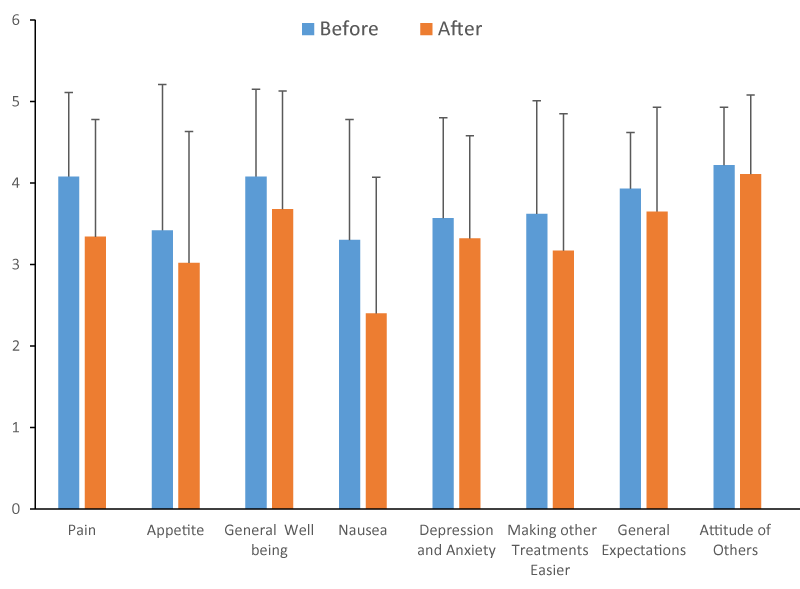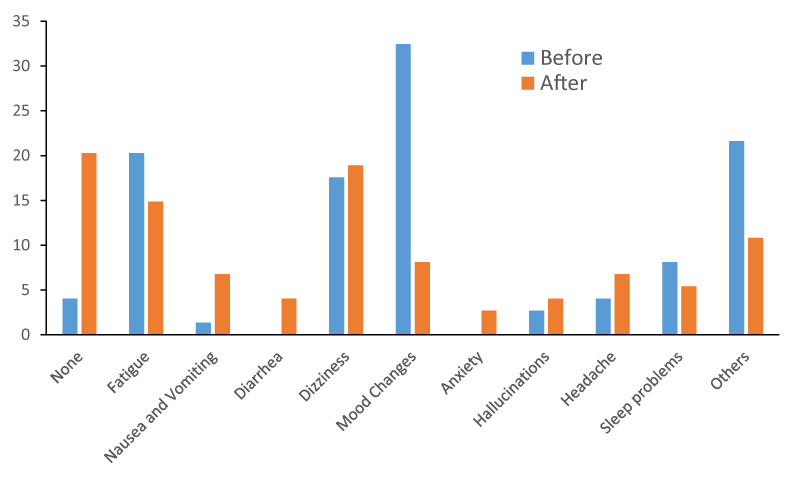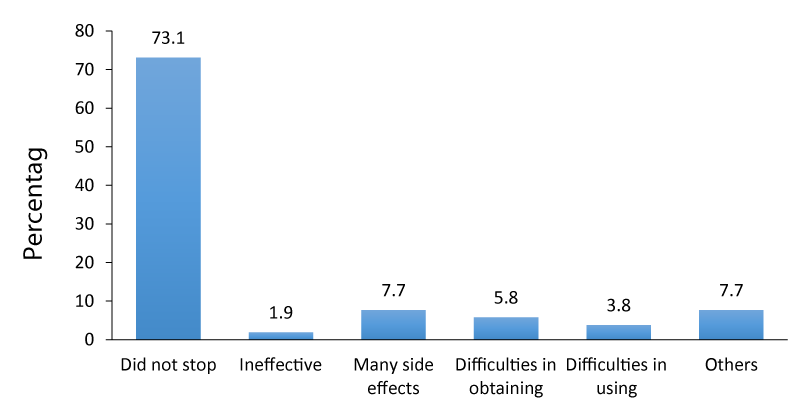More Information
Submitted: 09 June 2020 | Approved: 21 July 2020 | Published: 22 July 2020
How to cite this article: Ochayon L, Spiro H, Kadmon I. Expectations versus reality: Improvement of symptom control and quality of life of oncology patients using medical cannabis. Clin J Nurs Care Pract. 2020; 4: 027-031.
DOI: 10.29328/journal.cjncp.1001024
Copyright License: © 2020 Ochayon L, et al. This is an open access article distributed under the Creative Commons Attribution License, which permits unrestricted use, distribution, and reproduction in any medium, provided the original work is properly cited.
Keywords: Oncology patients; Medical cannabis; Expectations; Symptom control
Expectations versus reality: Improvement of symptom control and quality of life of oncology patients using medical cannabis
Lea Ochayon1*, Hana Spiro2 and Ilana Kadmon3
1Head Nurse of the Radiotherapy unit and Oncology Clinic, Hadassah Medical Organization, Jerusalem, Israel
2Oncology Clinic, Hadassah Medical Organization, Jerusalem, Israel
3Senior Lecturer, School of Nursing and Nurse Academic Consultant, Nursing Division, Hadassah Medical Organization, Jerusalem, Israel
*Address for Correspondence: Lea Ochayon, Oncology clinic, Sharett Institute, Hadassah Medical Center, P.O.B. 12000, Jerusalem 91120, Israel, Tel:+ 972-2-6777680; Email: [email protected]
Aim: To compare the expectations and the reality of oncology patients in terms of to the use of medical cannabis, including symptom control and related quality of life.
Research question: Is there a difference between oncology patients expectations and their reality concerning the use of medical cannabis and what do oncology patients experience regarding symptom control and quality of life?
Method: This research was done in a tertiary hospital in Israel at the oncology clinic A comparative study that used self- administered questionnaires for patients who received authorization to use medical cannabis. The first questionnaire was given to patients after receiving the authorization to use medical cannabis and asked about their expectations related to its use. Patients filled out the same questionnaire for the second time, approximately two months after. Comparison of the respondent’s answers, before and after using medical cannabis, showed reality of improving symptom control and Quality of Life.
Results: Seventy-four patients completed both questionnaires. Most patients reported advantage in symptom control when using medical cannabis, although their expectations were somewhat higher than the reality experienced. Advantage of using medical cannabis was also found concerning improvement of quality of life. Seventy-five of patients still used medical cannabis once completing the second questionnaire and most of them reported that they would recommend the use of medical cannabis.
Conclusion: It can be seen from this study that for many oncology patients the use of medical cannabis may be very helpful. However, the use of cannabis is not free of side effects, as can be seen from the patients’ reports. This has clear implications for oncology nursing practice and may lead to a better understanding of patients using medical cannabis in the future, in terms of its benefit and side effects.
As cited by MacCallum and Russo, [1] “Cannabis has a history of medical application likely exceeding that of the written word, including mainstream usage in Europe and North America for a century between 1840 and 1940. It is only in the last century that quality control issues, the lack of a defined chemistry, and above all, politically and ideologically motivated prohibition relegated it [1].
Cannabis began to attract renewed interest as medicine in the 1970s and 1980s, in particular due to its use by cancer and AIDS patients who reported relief from the effects of chemotherapy and wasting syndrome. While the scientific and medical communities continue to be divided on the therapeutic benefits and risks of cannabis use. Anecdotal evidence from medical users themselves suggests that using cannabis is indeed improving their quality of life by alleviating their pain and discomfort (Bogdanoski, 2010).
“United States is running way behind Spain and Israel, and Italy, where they are doing a lot more aggressive research with less interference from the government” as said by Dr. David Bearman who was interviewed about Cannabis in 2017 [2].
Medical organizations that have issued statements in support of allowing access to medical cannabis include the American Nurses Association (American Nurses Association, 2015).
In the mid-1990s, Ralph Mechaoulam, renowned Israeli researcher professor of medicinal chemistry at the Hebrew University of Jerusalem, made an exciting discovery that would forever change how we look at our biological relationship to plant medicine. Dr. Mechaoulam discovered a subtle system within the body that seemed to have a balancing effect on every other system. He called it the Endocannabinoid (EC) System and it can be found in all mammals, including humans. [3].
Unfortunately, physicians of the world remain profoundly uneducated concerning cannabis and the endocannabinoid system (ECS) that underlies much of its activity [1].
A new Israeli study supports the idea that cannabis could be used to kill cancer cells .Biologist Dr. David Meiri of the Technion-Israel Institute of Technology, is conducting cutting-edge research showing that combinations of different compounds in cannabis can be extremely effective in destroying specific cancer cells [4].
Rapidly - growing basic-science and clinical research literature providing insight into potential use of cannabis products for chronic pain, cancer management, and many other medical areas caused growing concerns and controversies focusing on overly -optimistic therapeutic claims and potential harms parallel recent expanded access to cannabis.
Changes in medical marijuana laws appear to be associated with increases in cannabis use and disorders among adults [5].
Potential effect of cannabis on mental health: acute intoxication and chronic use can exacerbate psychiatric symptoms. Also ,early cannabis use has been associated with onset of psychosis and risk for suicidality, and cannabis use can interfere with the treatment of mental disorders [6].
Some of the harms from acute intoxication as well as chronic use include impaired driving and learning capacity, poor educational and other social outcomes, motivation, adverse fetal outcomes, and other potential health effects [7]. All those should be taken into account when prescribing cannabis use.
Since there are controversies allowing use of medical cannabis, we decided as oncology nurses to develop a better evidence in understanding, regarding the expectations of cancer patients in reducing symptoms and compare with their actual experience with the compound.
Research aim
To compare the expectations and the reality of oncology patients in relation to the use of medical cannabis, including symptom control and related quality of life.
Sample
Patients who received approval to use medical cannabis were willing to take part in our study. 74 of them filled both questionnaires - the first regarding expectations and the second regarding reality.
The data was analyzed through statistical software SPSS version 25. At first, a descriptive statistics was done, and at the second stage, a categorical analysis was performed.
The difference between the first and the second questionnaire was done via T tests for dependent variables and Chi tests for categorical variables.
Ethical approval for this study was gained through the hospital review board Committee Number HMO – 0326-17.
The final sample consisted of 74 patients, 58% were woman and the average age was about 55 years, most patients were born in Israel (67%).
Regarding clinical data, it was found that only 16% of the sample had follow up in the pain clinic, about a fourth (28%) were smoking and only 4% were drinking excessively more than one glass of wine a day.
According to the patients report, regarding pain control, 65% got advice from the family doctor and 19% got advice for pain control from the oncologist. 41% of the sample did not use any pain control medications. When asked about who advised them to use medical Cannabis, it was found that half of the sample got the advice from their oncologist (51%) 10% got the advice from the oncology nurse, and 19% reported that they got the advice from other patients.
The main reason for Cannabis use was for pain control (65%), and about a fourth (27%) took it for the relief of other symptoms, such as fatigue and the improvement of the general well-being.
One third (31%) of the patients took medical cannabis believing that it will treat the cancer disease itself.
73% of patients said that they still used medical cannabis during the second questionnaire completion. Most were using it as oil compound (57%) and 44% used it as herbs compounds for smoking. The rate of its usage ranged from once a day to six times daily, with an average of 2.45 times a day.
When comparing expectations and reality (in a scale 0-5) concerning cannabis use it can be seen that in general expectations were somewhat higher than reality (Table 1 and Figure 1).
| Table 1: Differences between Expectations and Reality concerning the use of Medical Cannabis( in a scale 0-5). | ||||||
|
Before | After | t | p | ||
Variable |
Mean | Standard Deviation | Mean | Standard Deviation | t | p |
Pain |
4.08 | 1.03 | 3.34 | 1.44 | 3.46 | 0.001 |
Appetite |
3.42 | 1.79 | 3.02 | 1.61 | 1.61 | 0.065 |
General |
4.08 | 1.07 | 3.68 | 1.45 | 1.85 | 0.034 |
Nausea |
3.3 | 1.48 | 2.4 | 1.67 | 3.83 | <.001 |
Depression and Anxiety |
3.57 | 1.23 | 3.32 | 1.26 | 1.2 | 0.237 |
Making other Treatments Easier |
3.62 | 1.39 | 3.17 | 1.68 | 1.53 | 0.134 |
General Expectations |
3.93 | 0.69 | 3.65 | 1.28 | 1.43 | 0.154 |
Attitude of Others |
4.22 | 0.71 | 4.11 | 0.97 | 0.7 | 0.48 |
Figure 1: Comparing expectations before and after the use of Cannabis and the symptoms after the use of Cannabis( in a scale 0-5).
Regarding side effects: In general, cannabis may indeed increase side effects. Mood changes appears to be the most prominent positive side effect after using cannabis. Cannabis use decreases Fatigue and help patients to sleep better. On the other hand, we found that it increases Hallucinations, anxiety, nausea and vomiting, as well as headaches (Table 2 and Figure 2). Most patients were satisfied with cannabis use, although a few stopped it because of related side effects (Figure 3).
| Table 2: Comparing the expectations before and reality after using Medical Cannabis also regarding side effects. | |||||
| Side effects | Before | After | P | ||
| Frequency | % | Frequency | % | ||
| None | 3 | 4.05 | 15 | 20.27 | <.001 |
| Fatigue | 15 | 20.27 | 11 | 14.86 | 0.032 |
| Nausea and Vomiting | 1 | 1.35 | 5 | 6.76 | 0.062 |
| Diarrhea | 0 | 0 | 3 | 4.05 | 0.021 |
| Dizziness | 13 | 17.57 | 14 | 18.92 | 0.471 |
| Mood Changes | 24 | 32.43 | 6 | 8.11 | 0.012 |
| Anxiety | 0 | 0 | 2 | 2.7 | 0.241 |
| Hallucinations | 2 | 2.7 | 3 | 4.05 | 0.102 |
| Headache | 3 | 4.05 | 5 | 6.76 | 0.16 |
| Sleep problems | 6 | 8.11 | 4 | 5.41 | 0.192 |
| Others | 16 | 21.62 | 8 | 10.81 | 0.072 |
Figure 2:
Figure 3: Reasons for stopping the use of Medical Cannabis.
As seen in this figure on the left side: by large most patients did not stop using cannabis (73.1%) after receiving permission to use it, and would even recommend it to other oncology patients.
Reasons cited by patients for stopping cannabis use were:
Founding it not effective (1.9%), having many side effects (7.7%), medical cannabis was unavailable (5.8%), difficulties in using cannabis (3.8%) and other reasons for stopping cannabis (7.7%).
This study was an analysis of one clinic within the total treatment trajectory of oncology patients in a large tertiary medical center.
The main reason for medical Cannabis use was for pain control (65%), about a fourth (27%) took it for the relief of other symptoms, such as fatigue and the improvement of their general well-being.
As was found in this study, for many oncology patients the use of cannabis may be very helpful and most of them decided not to stop using it (71.1%).
According to Bogdanski (2010) medical cannabis use by cancer patients relieved them from the effects of chemotherapy, as was clearly found in our study and shown in figure 1.
However, the use of cannabis is not free of side effects, as can be seen from the patient›s reports, almost 80% suffered from some side effects from medical cannabis use.
Moreover, some potential effect of cannabis on mental health may be: acute intoxication and chronic use can exacerbate psychiatric symptoms. Also, early cannabis use has been associated with onset of psychosis and risk for suicidality, and cannabis use can interfere with the treatment of mental disorders [6].
As seen in figure 1, the expectations of patients are somehow higher from the reality they experienced while using cannabis. It was interesting to note, that most patients continued using medical cannabis and even recommended it to other oncology patients.
One third (31%) of the patients asked in our study, took medical cannabis believing that it will treat the cancer disease itself. It may be based on research showing that combinations of different compounds in cannabis can be extremely effective in destroying specific cancer cells [4].
Study limitations
This study had a few clear limitations; a convenient rather small sample was employed without any control group. Patients with different cancer types and different stages of the disease were enrolled in this study, a fact that can influence patients overall symptoms and their need for cannabis. This study was conducted in only one hospital in Israel. It was done only in one period of time. The questionnaires were only in Hebrew. Some patients after filling the first questionnaire, did not complete the second one.
This study shows that for many oncology patients the use of medical cannabis may be very helpful. However, the use of cannabis is not free of side effects, as can be seen from the patients’ reports.
Potential effect of cannabis on mental health: acute intoxication and chronic use can exacerbate psychiatric symptoms. Also, early cannabis use has been associated with onset of psychosis and risk for suicidality.
Some of the harms from acute intoxication as well as chronic use include impaired driving and learning capacity, poor educational and other social outcomes, motivation, adverse fetal outcomes, and other potential health effects [7].
All those should be taken into account when prescribing medical cannabis use.
Changes in medical marijuana laws appear to be associated with increases in cannabis use [5].
Unfortunately, physicians of the world remain profoundly uneducated. Concerning cannabis and the endocannabinoid system (ECS) that underlies much of its activity [1].
Israel is one of the leading countries which studies the issue deeply and lately made its use legal for oncology patients.
As shown in our study medical cannabis use, reduces symptoms of cancer disease and its treatments and an increase number of oncology patients ask for authorizations to use it.
Cannabis use should not be recommended to every-one; patient disease, age and other illnesses should be noted. Therefore, cannabis must be applied after a thorough doctor’s check who has the license to write a prescription for Medical Cannabis.
We still do not know the long-term side effects and damages of cannabis and therefore, more medical and nursing studies are strongly needed, since the official use of cannabis is relatively new.
Relevance for oncology nursing
Medical and nursing organizations have issued statements in support of allowing access to medical cannabis. An example is the American Nurses Associations (American Nurses Association, 2015).
As oncology nurses, one of our aims is to improve patient›s quality of life by reducing symptoms caused by the disease and related treatment and therefore, we must be aware of the advantages, as well as some disadvantages of medical cannabis.
- MacCalluma C, Russob E. Practical considerations in medical cannabis administration and dosing", European Journal of Internal Medicine. 2018; 49: PubMed: https://pubmed.ncbi.nlm.nih.gov/29307505/
- https://greendorphin.com/dr-david-bearman-cannabis-cancer-/interview-nimbin-mardigrass-2017
- Cannabis and Cancer: How "Marijuana" Helps the Body Heal. https://thetruthaboutcancer.com/cannabis-and-cancer
- Taha T, Meiri D, Talhamy S, Wollner M, Peer A, et al. Cannabis Impacts Tumor Response Rate to Nivolumab in Patients with Advanced Malignancies. The Oncologist. 2019; 24.
- Compton W, Volkow N, Lopez M. Medical Marijuana Laws and Cannabis Use - Intersections of Health and Policy. JAMA Psychiatry. 2017; 74: 559-560. PubMed: https://pubmed.ncbi.nlm.nih.gov/28445570/
- Hasin DS, Sarvet AL, Cerdá M, Keyes KM, Stohl M, et al. US adult illicit cannabis use, cannabis use disorder, and medical marijuana laws: 1991-1992 to 2012-2013. JAMA Psychiatry. 2017; 74: 579-588. PubMed: https://pubmed.ncbi.nlm.nih.gov/28445557/
- National Academies of Sciences, Engineering and Medicine. The Health Effects of Cannabis and Cannabinoids: Current State of Evidence and Recommendations for Research. Washington, DC: The National Academies Press; 2017. PubMed: https://www.ncbi.nlm.nih.gov/books/NBK423845/
- Balneaves L, Alraja A. Guarding their practice: a descriptive study of Canadian nursing policies and education related to medical cannabis. B.M.C. Nursing. 2019; 18: 66.
- Beare M, LeBaron V, Gilson A. The use of Cannabis in response to the opioid crisis: A review of the literature. 2017. PubMed: https://pubmed.ncbi.nlm.nih.gov/28993073/
- Palace ZJ, Reingold DA. Medical Cannabis in skilled nursing facility: A novel approach to improving symptom management and quality of life. JAMDA. 2019; 20: 94-98. https://pubmed.ncbi.nlm.nih.gov/30580820


